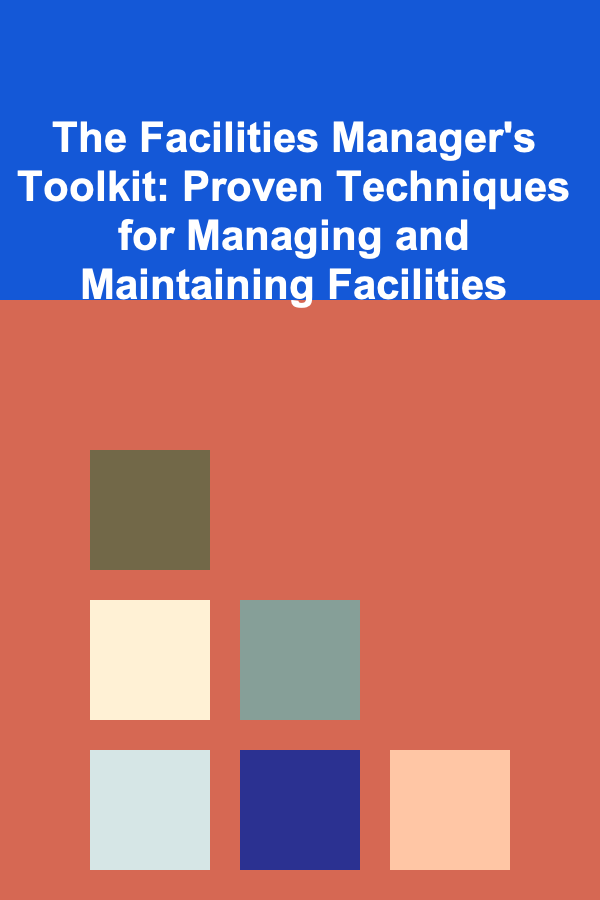
The Facilities Manager's Toolkit: Proven Techniques for Managing and Maintaining Facilities
ebook include PDF & Audio bundle (Micro Guide)
$12.99$6.99
Limited Time Offer! Order within the next:

Effective facilities management is essential for maintaining a safe, functional, and productive environment in any organization. A facilities manager oversees various aspects of building operations, ranging from maintenance to safety compliance and energy efficiency. With responsibilities spanning numerous areas, it's crucial to have the right tools and techniques in place to streamline operations and achieve long-term success.
In this actionable guide, we will explore proven techniques and best practices that facilities managers can employ to optimize facility management. These strategies will help manage and maintain facilities efficiently, reduce costs, and enhance the overall experience for occupants.
Prioritize Preventive Maintenance
One of the cornerstones of successful facilities management is preventive maintenance. By proactively addressing maintenance needs before they become serious problems, you can significantly extend the life of your assets, reduce downtime, and lower repair costs.
Why Preventive Maintenance Works:
- Cost Savings: Regularly maintaining equipment and systems reduces the likelihood of costly emergency repairs or replacements.
- Improved Asset Longevity: Equipment, systems, and infrastructure that are well-maintained are more likely to last longer and function optimally.
- Operational Continuity: Preventive maintenance helps avoid unexpected failures that could disrupt day-to-day operations.
Proven Techniques for Preventive Maintenance:
- Scheduled Inspections: Set up a regular inspection schedule for all critical systems (HVAC, plumbing, electrical, etc.). This ensures early identification of issues.
- Predictive Maintenance Tools: Implement technologies that predict failures based on real-time data (such as vibration sensors or temperature monitoring systems).
- Maintenance Logs: Keep detailed maintenance logs for each asset. This helps track the history of repairs, servicing, and any issues that arise.
Using a Computerized Maintenance Management System (CMMS) can help automate this process by providing reminders for inspections, repairs, and parts replacement. This system can track the entire lifecycle of equipment and provide reports to assess performance.
Implement Smart Energy Management
Energy efficiency has become a critical concern in facilities management, especially with rising utility costs and growing environmental concerns. Implementing smart energy management techniques can help facilities managers reduce energy consumption, lower costs, and support sustainability initiatives.
Key Elements of Energy Management:
- Building Automation Systems (BAS): Use BAS to control heating, cooling, lighting, and security systems from a centralized platform. Smart systems adjust settings based on occupancy, time of day, or external weather conditions, optimizing energy use.
- Energy Audits: Conduct regular energy audits to assess your building's energy usage. Identify areas of inefficiency, such as outdated HVAC systems or lighting that runs unnecessarily.
- LED Lighting and Smart Thermostats: Switch to energy-efficient LED lighting and install smart thermostats that adjust temperatures based on room occupancy or time schedules.
Proven Techniques:
- Track Energy Consumption: Use energy monitoring tools to track energy consumption across different building zones and systems. This helps identify inefficiencies and target areas for improvement.
- Employee Education: Educate employees on energy-saving practices, such as turning off lights when not in use or using natural light as much as possible.
- Sustainability Goals: Set long-term sustainability goals, such as reducing energy use by a certain percentage each year or achieving LEED certification. Aligning facility operations with these goals will drive continuous improvement.
By utilizing energy management tools and adopting energy-saving practices, facilities managers can achieve significant cost savings and contribute to environmental sustainability.
Ensure Compliance with Safety and Regulatory Standards
Safety and compliance are non-negotiable aspects of facilities management. Facilities managers must ensure that their buildings comply with local, state, and federal regulations, including fire safety, environmental standards, and accessibility guidelines.
Key Areas of Compliance:
- Fire Safety: Regular inspections of fire alarms, sprinklers, and fire extinguishers are essential for ensuring the safety of occupants. Develop and maintain an emergency evacuation plan.
- OSHA Regulations: Ensure that the workplace meets Occupational Safety and Health Administration (OSHA) standards, including proper signage, hazard communication, and employee training.
- Accessibility: Compliance with the Americans with Disabilities Act (ADA) is crucial. Facilities should be accessible to individuals with disabilities, including appropriate signage, ramps, and elevators.
Proven Techniques:
- Regular Inspections and Audits: Conduct frequent safety audits and ensure that all safety systems are operational. Use a checklist for all fire safety equipment and emergency exits.
- Safety Training Programs: Offer safety training to employees regularly, especially for those involved in maintenance, janitorial services, and construction. This ensures they are prepared for emergencies.
- Stay Updated on Regulations: Regulatory standards and codes can change over time. Stay updated on the latest industry standards to ensure ongoing compliance.
Using a compliance management tool can simplify the process of tracking inspections, repairs, and safety certifications. This allows facilities managers to stay ahead of potential compliance issues and avoid penalties.
Leverage Technology for Streamlined Operations
In today's fast-paced world, technology is a game-changer for facilities management. Leveraging technology can streamline operations, improve communication, and reduce manual labor.
Key Technologies for Facilities Management:
- Facility Management Software (FMS): FMS centralizes all your facility's data, including maintenance requests, work orders, and equipment inventories. This allows for better decision-making and more efficient resource allocation.
- Mobile Access: Mobile-enabled platforms allow facilities managers and maintenance teams to access information in real-time, even while on the go. This improves communication and responsiveness.
- IoT Devices: The Internet of Things (IoT) enables devices to communicate with each other and send real-time data. For example, smart sensors in HVAC systems can report temperature or humidity changes, allowing for faster intervention.
Proven Techniques:
- Automated Scheduling and Notifications: Use software to automatically schedule maintenance tasks and send alerts when issues arise. This reduces the need for manual tracking and helps ensure that no tasks are overlooked.
- Real-Time Monitoring: Use IoT sensors to monitor critical systems, such as HVAC, lighting, and plumbing. Real-time data allows for rapid responses to potential issues.
- Cloud-Based Platforms: Storing data on cloud-based platforms ensures that information is accessible to all relevant parties, whether they're on-site or working remotely.
By leveraging technology, facilities managers can reduce downtime, improve operational efficiency, and make data-driven decisions that lead to better outcomes.
Foster Effective Communication and Collaboration
Effective communication and collaboration are essential to ensuring smooth operations in facilities management. Facilities managers often work with various stakeholders, including maintenance teams, vendors, contractors, and building occupants.
Key Communication Strategies:
- Clear Reporting Channels: Establish clear channels for reporting issues, whether through a work order system, email, or instant messaging. Ensure that all stakeholders know where and how to report problems.
- Collaboration Tools: Use tools like project management software to coordinate tasks and collaborate with internal teams or external contractors. This ensures that projects stay on schedule and within budget.
- Regular Meetings: Hold regular meetings with maintenance staff, vendors, and contractors to discuss ongoing projects, potential challenges, and upcoming needs.
Proven Techniques:
- Task Management Systems: Use task management systems to assign and track tasks. These systems help ensure that all team members are aware of their responsibilities and deadlines.
- Feedback Mechanisms: Create a feedback loop where tenants, employees, and contractors can provide feedback on facility services. This helps identify areas for improvement and boosts customer satisfaction.
- Mobile Communication: Use mobile communication apps like Slack or Microsoft Teams to facilitate quick, real-time communication between teams and vendors.
By fostering an environment of open communication and collaboration, facilities managers can ensure that everyone is on the same page and that operations run smoothly.
Track and Optimize Budget and Resources
Budget management is a critical responsibility of facilities managers. Effective tracking of spending on maintenance, repairs, utilities, and supplies ensures that resources are being used efficiently and that financial goals are met.
Budgeting Techniques:
- Detailed Cost Tracking: Maintain detailed records of all expenditures related to the facility. This includes maintenance costs, utility bills, and capital improvement projects.
- Forecasting and Planning: Use historical data to forecast future expenses and plan budgets accordingly. This helps ensure that you have sufficient funds for both routine maintenance and unexpected repairs.
- Cost Reduction Strategies: Look for opportunities to reduce costs, such as renegotiating contracts with suppliers, consolidating services, or implementing energy-saving initiatives.
Proven Techniques:
- Expense Categorization: Categorize expenses into various types (maintenance, utilities, capital expenditures) to identify trends and areas for improvement.
- Vendor Management: Maintain good relationships with contractors and service providers to ensure competitive pricing and quality service.
- Efficiency Audits: Conduct regular efficiency audits to identify areas where resources are being wasted, whether in terms of energy consumption, labor, or supplies.
By tracking and optimizing the budget, facilities managers can ensure that their operations are cost-effective while still meeting the needs of building occupants.
Conclusion
Successful facilities management is a dynamic and complex task that requires a blend of technical expertise, strategic planning, and efficient resource management. By prioritizing preventive maintenance, implementing smart energy management, ensuring regulatory compliance, leveraging technology, fostering communication, and optimizing budgets, facilities managers can create safe, efficient, and sustainable environments.
The tools and techniques outlined in this guide can help facilities managers streamline operations, reduce costs, and improve overall facility performance, leading to enhanced productivity and satisfaction for both building occupants and stakeholders.
Reading More From Our Other Websites
- [Digital Decluttering Tip 101] Digital Declutter: A Beginner's Roadmap to Minimalist Tech Use
- [Biking 101] Top 5 Cycling Apparel Brands You Need to Know About
- [Home Rental Property 101] How to Navigate the Apartment for Rent Market and Secure Your Dream Downtown Pad
- [Personal Investment 101] How to Use Deep Learning to Build Profitable SaaS Products
- [Home Budget Decorating 101] How to Shop Smart for Home Decor on a Budget
- [Home Rental Property 101] How to Protect Your Security Deposit on Houses for Rent
- [Home Cleaning 101] How to Deep Clean a Bathroom: A Comprehensive Guide
- [Home Staging 101] How to Choose the Right Color Palette for Staging
- [Home Security 101] How to Secure Your Home While on Out-of-Town Trips: Essential Security Tips
- [Star Gazing Tip 101] Dreaming in the Dark: Harnessing the Magic of the Night Sky for Personal Growth

How to Make Use of Lofted Spaces for Storage
Read More
How to Organize Kids' Toys with a Minimalist Mindset
Read More
Understanding the Role of Real Estate in FIRE (Financial Independence, Retire Early)
Read More
Developing AR for Healthcare Professionals: A Deep Dive
Read More
How to Use Form 8822: Change of Address
Read More
How to Customize Your Meditation Checklist for Different Techniques
Read MoreOther Products

How to Make Use of Lofted Spaces for Storage
Read More
How to Organize Kids' Toys with a Minimalist Mindset
Read More
Understanding the Role of Real Estate in FIRE (Financial Independence, Retire Early)
Read More
Developing AR for Healthcare Professionals: A Deep Dive
Read More
How to Use Form 8822: Change of Address
Read More